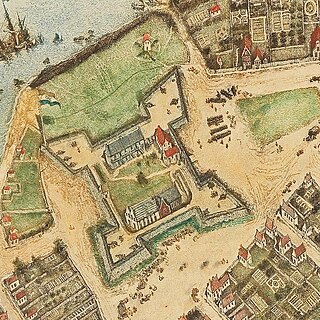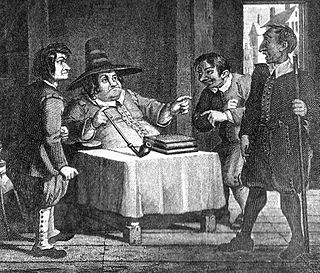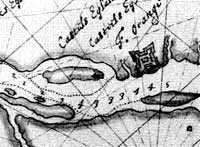
New Amsterdam was a 17th-century Dutch settlement established at the southern tip of Manhattan Island that served as the seat of the colonial government in New Netherland. The initial trading factory gave rise to the settlement around Fort Amsterdam. The fort was situated on the strategic southern tip of the island of Manhattan and was meant to defend the fur trade operations of the Dutch West India Company in the North River. In 1624, it became a provincial extension of the Dutch Republic and was designated as the capital of the province in 1625. New Amsterdam became a city when it received municipal rights on February 2, 1653.

New Netherland was a 17th-century colonial province of the Dutch Republic located on the east coast of what is now the United States of America. The claimed territories extended from the Delmarva Peninsula to Cape Cod. Settlements were established in what became the states of New York, New Jersey, Delaware, and Connecticut, with small outposts in Pennsylvania and Rhode Island.

The Mohicans are an Eastern Algonquian Native American tribe that historically spoke an Algonquian language. As part of the Eastern Algonquian family of tribes, they are related to the neighboring Lenape, whose indigenous territory was to the south as far as the Atlantic coast. The Mohican lived in the upper tidal Hudson River Valley, including the confluence of the Mohawk River and into western New England centered on the upper Housatonic River watershed. After 1680, due to conflicts with the powerful Mohawk to the west during the Beaver Wars, many were driven southeastward across the present-day Massachusetts western border and the Taconic Mountains to Berkshire County around Stockbridge, Massachusetts.

Adriaen Courtsen Block was a Dutch private trader, privateer, and ship's captain who is best known for exploring the coastal and river valley areas between present-day New Jersey and Massachusetts during four voyages from 1611 to 1614, following the 1609 expedition by Henry Hudson. He is noted for possibly having named Block Island, Rhode Island, and establishing early trade with the Native Americans, and for the 1614 map of his last voyage on which many features of the mid-Atlantic region appear for the first time, and on which the term New Netherland is first applied to the region. He is credited with being the first European to enter Long Island Sound and the Connecticut River, and to determine that Manhattan and Long Island are islands.

Fort Amsterdam was a fortification on the southern tip of Manhattan Island at the confluence of the Hudson and East rivers. The fort and the island were the center of trade and the administrative headquarters for the Dutch and then British/Colonial rule of the colony, of New Netherland and thereafter the Province of New York. The fort was the nucleus of the settlement on the island and greater area, which was named New Amsterdam by the first Dutch settlers, and eventually renamed New York by the English, and was central to much of New York's early history.

Fort Orange was the first permanent Dutch settlement in New Netherland; the present-day city of Albany, New York developed at this site. It was built in 1624 as a replacement for Fort Nassau, which had been built on nearby Castle Island and served as a trading post until 1617 or 1618, when it was abandoned due to frequent flooding. Both forts were named in honor of the Dutch House of Orange-Nassau. Due to a dispute between the Director-General of New Netherland and the patroonship of Rensselaerswyck regarding jurisdiction over the fort and the surrounding community, the fort and community became an independent municipality, paving the way for the future city of Albany. After the English reconquered the region they soon abandoned Fort Orange in favor of a new fort: Fort Frederick, constructed in 1676.

Wouter van Twiller was an employee of the Dutch West India Company and the fourth Director of New Netherland. He governed from 1632 until 1638, succeeding Peter Minuit, who was recalled by the Dutch West India authorities in Amsterdam for unknown reasons.
Cornelis Jacobsen Mey, often spelled Cornelius Jacobsz May in Dutch, was a 17th-century century Dutch explorer, captain, and fur trader. Mey was the first Director of New Netherland and was stationed at Fort Amsterdam. Mey was the captain of the ship Nieu Nederlandt which delivered the first boat load of colonists to New Netherland in north-east America.

Rensselaerswyck was a Dutch colonial patroonship and later an English manor owned by the van Rensselaer family located in the present-day Capital District of New York in the United States.

New Netherland Company was a chartered company of Dutch merchants.
Hendrick Christiaensen was a Dutch explorer who was involved in the earlier exploration of what became the colony of New Netherland.

Castle Island is a former island located in the city of Albany, Albany County, New York. Over the past 400 years, Castle Island has been referred to as Martin Gerritse's Island, Patroon's Island, Van Rensselaer Island, and—since the late 19th century--Westerlo Island. The land known as Castle Island has been connected to the mainland and now forms a part of the Port of Albany.

Fort Nassau was a factorij in New Netherland between 1624–1651 located at the mouth of Big Timber Creek at its confluence with the Delaware River. It was the first known permanent European-built structure in what would become the state of New Jersey. The creek name is a derived from the Dutch language Timmer Kill as recorded by David Pietersen de Vries in his memoirs of his journey of 1630–1633. The Delaware Valley and its bay was called the "South River" ; the "North River" of the colony was the Hudson River. The factorij was established for the fur trade, mostly in beaver pelts, with the indigenous populations of Susquehannock, who spoke an Iroquoian language, and the Lenape, whose language was of the Algonquian family. They also wanted to retain a physical claim to the territory.
Fort Wilhelmus was a factorij in the 17th-century colonial province of New Netherland, located on what had been named Hooghe Eyland on the Zuyd Rivier, now Burlington Island in the Delaware River in New Jersey. More a trading post than a military installation, it was built in 1625 by colonists from the Netherlands in the employ of the Dutch West India Company, with the intention of establishing a physical claim to the new territory and to engage in the fur trade with the indigenous population of Lenape and Minqua. The Walloon families had originally arrived at Noten Island across from New Amsterdam in the Upper New York Bay, They had been sent south in order to begin the population of the province of New Netherland. They were later recalled to Fort Amsterdam since the Dutch West India Company had decided to concentrate their settlement efforts along the North River, or Hudson River.

Fort Beversreede was a Dutch-built palisaded factorij located near the confluence of the Schuylkill River and the Delaware River. It was an outpost of the colony of New Netherland, which was centered on its capital, New Amsterdam (Manhattan), on the North River.

New Netherland, or Nieuw-Nederland in Dutch, was the 17th century colony of the Republic of the Seven United Netherlands on the northeastern coast of North America. The claimed territory included southern Cape Cod to parts of the Delmarva Peninsula. Settled areas are now part of the Mid-Atlantic states of New York, New Jersey, Connecticut, Delaware and Pennsylvania. Its capital, New Amsterdam, was located at the southern tip of the island of Manhattan on Upper New York Bay.
Kenwood was a hamlet in the Town of Bethlehem, New York. The hamlet spanned both sides of the Normans Kill near the area where the Normans Kill flows into the Hudson River. In 1870, and again in 1910, northern portions of Kenwood were annexed by the City of Albany, New York.

The history of Albany, New York prior to 1664 begins with the native inhabitants of the area and ends in 1664, with the English takeover of New Netherland. The area was originally inhabited by Algonquian Indian tribes and was given different names by the various peoples. The Mohican called it Pempotowwuthut-Muhhcanneuw, meaning "the fireplace of the Mohican nation", while the Iroquois called it Sche-negh-ta-da, or "through the pine woods". Albany's first European structure was a primitive fort on Castle Island built by French traders in 1540. It was destroyed by flooding soon after construction.
Adriaen Jorissen Thienpoint or Tienpoint was a Dutch sea captain-explorer who commanded several ships to the newly developing colonies of New Netherland and New Sweden as well as other holdings of the Dutch Empire in North America in the early 17th century.

Johannes Megapolensis (1603–1670) was a dominie (pastor) of the Dutch Reformed Church in the Dutch colony of New Netherland, beginning in 1642. Serving for several years at Fort Orange on the upper Hudson River, he is credited with being the first Protestant missionary to the Indians in North America. He later served as a minister in Fort Amsterdam on Manhattan Island, staying through the takeover by the English in 1664.

















